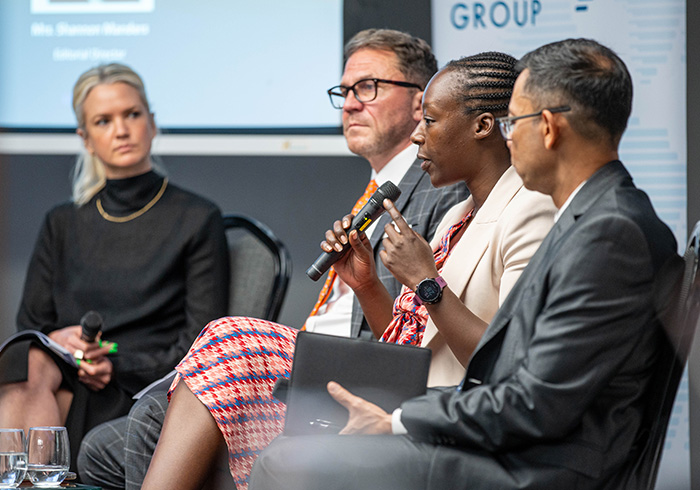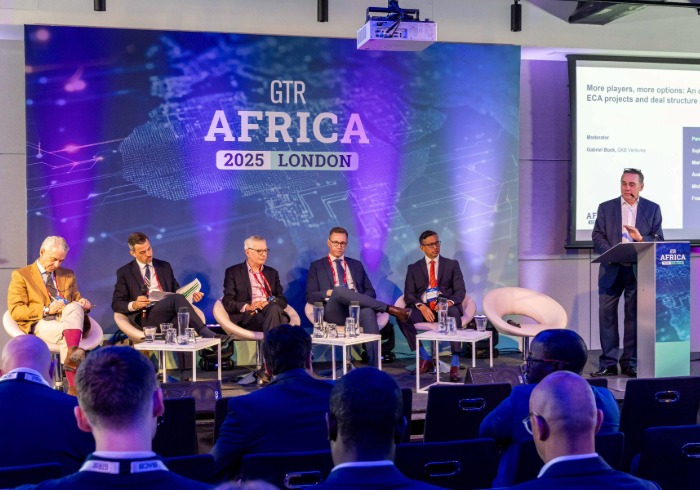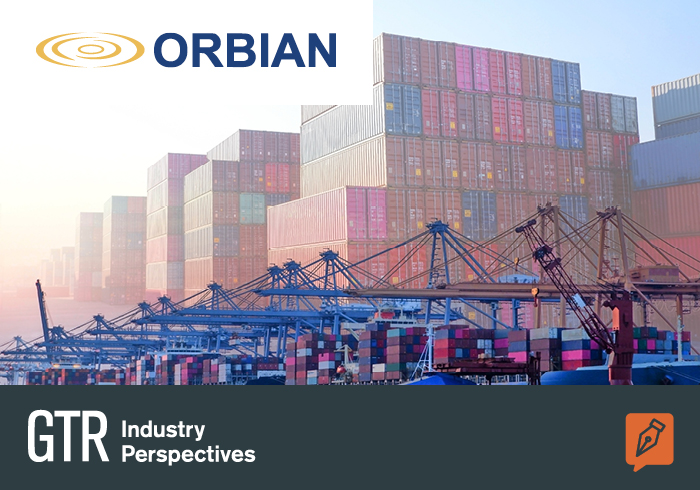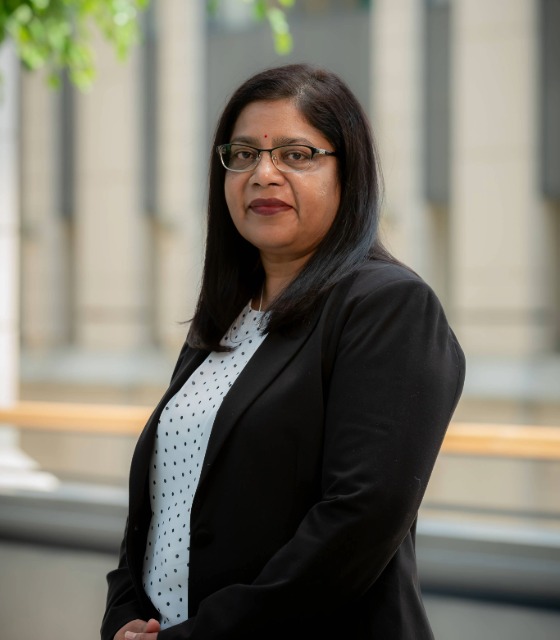Africa has the liquidity to finance its own trade, but the lack of alternative investment products, regulatory barriers, bank de-risking and persistent misconceptions about trade finance risk continue to choke the flow of institutional capital into the real economy. This was the warning from senior market players at a Mauritius investor forum co-hosted by the Trade and Development Bank (TDB) Group and GTR in early November.
Opening the event, Admir Imami, senior advisor, trade finance fund operations at TDB Group, said the gathering came “at a pivotal moment, one in which Africa’s ability to fund its own trade and development is not just a question of capital, but a question of vision, confidence and collaboration”.
He described trade finance as “a mature, defensive and attractive… private credit asset class”, arguing that Africa’s domestic investible base is estimated at around US$1.4tn, of which “probably less than 1%” is allocated to alternative investments, like trade finance.
“Africa has enough money to fund its own trade – the issue is that it’s highly fragmented,” said George Wilson, chief executive of ARM Trade Finance Fund, speaking on a panel moderated by GTR.
“Regulation and the implementation of Basel capital requirements rules make African trade finance unprofitable for many banks. That pushes capital into government bonds rather than the real economy.”
Wilson warned that banking regulation continues to be the single biggest structural force reshaping African trade finance, discouraging banks from supporting SME flows and limiting the supply of assets investors can access.
Periodic failures and defaults, “the likes of Greensill, Abraaj, Carillion, Barak and most recently First Brands”, have also dented investor confidence, he added, despite trade finance’s historically low default rates.
“Funds have failed for three reasons: corporate fraud, concentration risk and liquidity mismatches,” Wilson said.
“None of these are inherent flaws of the asset class, but they colour investor perception. Our job [as investment professionals] is to explain the difference between those failures and African trade finance, which is rooted in real, self-liquidating economic activity.”
African institutional investors lead the charge
For TDB Group, which has grown its asset management business to one of the largest trade finance platforms on the continent, African pension funds – alongside other African institutional investors such as sovereign wealth funds, asset managers, and insurance and reinsurance companies – have now become the biggest driver of demand, said Umulinga Karangwa, chief investment officer and executive director at Eastern and Southern African Trade Advisers Limited (ESATAL).
ESATAL is a TDB Group wholly owned fund management company domiciled in Mauritius, which manages the Eastern and Southern African Trade Fund (ESATF), a short- to medium-term trade finance investment fund that channels capital into trade transactions across the region, including for SMEs. The fund finances banks and corporates through instruments such as letters of credit, risk participation structures and other self-liquidating trade assets.
“Under ESATF, we have US$414mn in gross assets under management and 72 investors today, most allocating to trade finance for the first time,” said Karangwa. “This comes after years of education – with regulators, trustees and investment committees. They want liquidity, short duration and dollar exposure, but they also want impact.”
Building on that traction, Karangwa said TDB Group this year launched a second fund aimed at investors willing to commit capital for longer than the three-month notice period offered under ESATF.
After six years of consistent performance from its first short-term liquidity vehicle, many investors no longer need funds returned every quarter and are now seeking higher returns by locking in for a year or more, she said.
While returns are still tied to the global macroeconomic environment and remain uncorrelated with equity markets, she said appetite for the asset class has become far more steady and strategic.
Regulation, however, is the biggest barrier to unlocking additional local capital: many African pension funds are still barred from investing in neighbouring markets, making diversification difficult and returns lower, she said.
SME financing still stuck
While cross-border commodity flows continue to dominate African trade finance portfolios, the panellists stressed the need for deeper financial support to MSMEs, the continent’s largest source of employment but its least-served segment.
“Most SMEs don’t have access to banking facilities,” said Avinash Jahajeeah, head of trade finance and syndications at BCP Bank Mauritius. “To support them, we need DFI backing, insurers and collateral managers so we can unlock working capital and manage the risks along the supply chain.”
Wilson at ARM argued that FI trade structures – portfolio facilities to African banks and non-bank financial institutions – offer a scalable solution by aggregating thousands of SME invoices into investable assets.
“There are billions of SME invoices in Africa. You can’t fund them individually, but you can fund the financial institutions that already do,” Wilson said. “This is where African trade finance becomes investable at scale, and where blended finance can crowd in commercial money.”
The panellists highlighted Mauritius’ role as a conduit for African trade flows, offering tax efficiency, legal stability and proximity to both African assets and international investors. Several large African financial institutions now structure funds and special purpose vehicles on the island.
BCP Bank Mauritius, part of Morocco’s BCP Group, has noted rising demand for non-traditional structures – from structured commodity finance to supply chain finance – as clients adapt to currency volatility, supply chain disruptions and shifting trade corridors, Jahajeeah said.
What would unlock investor participation fastest?
Panellists suggested that regulatory reform and better alignment with the realities of African trade could mobilise billions of African capital almost immediately.
Karangwa called for “more science-based regulation” that allows country-specific African institutional investors to diversify across African markets rather than restricting capital within borders.
Wilson urged a rethink of how Basel rules are applied on the continent and called for mechanisms to close the communication gap between impact-oriented funds and global pools of capital.
Jahajeeah added that the “ideal product would be a dedicated trade finance fund with a DFI or insurance component – and preferably rated”.
“That would give some credibility and transparency; it will attract a more diversified investor base to these kinds of funds to support this business,” he said.
The issue of ratings was taken up in the panel that followed, where Imami argued that African trade finance vehicles need credible, locally grounded rating capacity because global agencies often lack the depth to assess the asset class.
He was backed by Saurav Chatterjee, CEO of Care Ratings Africa, who stressed that investors should look beyond the letter grade and focus on the rating rationale: the detailed, transaction-level analysis of security, structure and risk that is essential for understanding performance.
Speaking to GTR after the event, Karangwa said ESATF’s investment-grade AAAf and A- ratings from Care Ratings and Japan’s JCR, respectively, were both affirmed in the past few weeks.
“This is thanks to the fund’s steady performance, the healthy quality of its portfolio, strong investment and credit guidelines, and ESATAL’s solid capacity to manage the assets,” she said.








